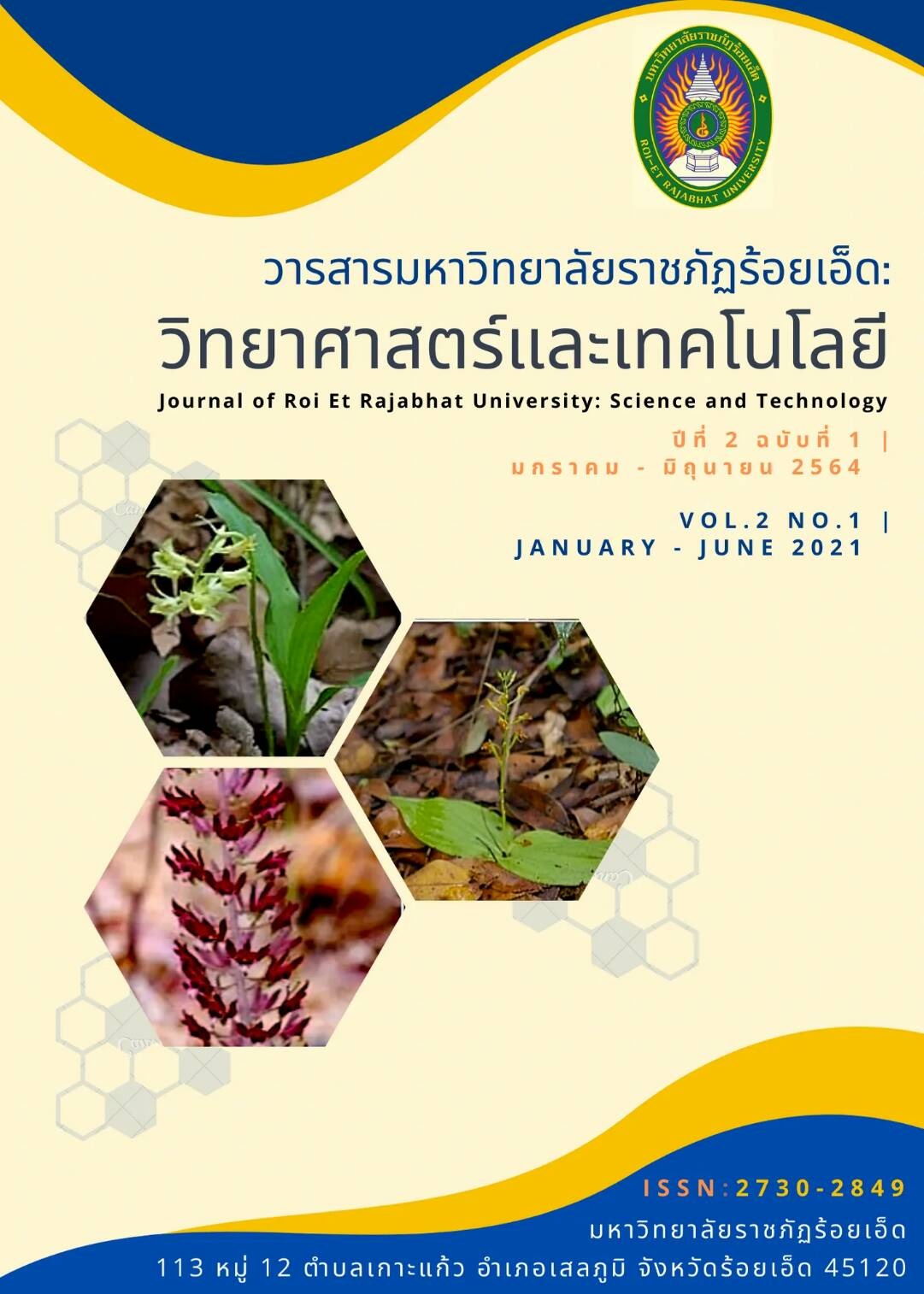ความหลากชนิดของไม้ต้น ปริมาณคาร์บอนสะสม และการใช้ประโยชน์ในป่าโคกทุ่งบะ มหาวิทยาลัยราชภัฏร้อยเอ็ด
คำสำคัญ:
ความหลากหลายทางชีวภาพ, มวลชีวภาพ, คาร์บอนเครดิต, ป่าชุมชน, การใช้ประโยชน์จากพืชบทคัดย่อ
การศึกษาในครั้งนี้มีวัตถุประสงค์เพื่อศึกษาความหลากชนิดของไม้ต้น ปริมาณคาร์บอนสะสมและการใช้ประโยชน์ของไม้ต้นในป่าโคกทุ่งบะ ในเขตมหาวิทยาลัยราชภัฏร้อยเอ็ด โดยการวางแปลงแบบสุ่มขนาด 10 x 10 เมตร จำนวน 46 แปลง โดยทำการศึกษาในระหว่างเดือนมีนาคม-เดือนธันวาคม พ.ศ. 2561 สำรวจและระบุชนิดของไม้ต้น นับจำนวน วัดความสูง และวัดขนาดเส้นผ่าศูนย์กลางที่ระดับอก (DBH) มากกว่า 10 เซนติเมตรขึ้นไป สอบถามการใช้ประโยชน์ของไม้ต้นในเขตป่าโคกทุ่งบะ 2 หมู่บ้าน ได้แก่บ้านเหล่าแขม และบ้านดงกลาง ตำบลเกาะแก้ว อำเภอเสลภูมิ จังหวัดร้อยเอ็ด โดยทำการศึกษาระหว่างเดือนมีนาคม- ธันวาคม 2561 ผลการศึกษาพบไม้ต้นทั้งหมด 76 ชนิด 60 สกุล 38 วงศ์ สามารถระบุชนิดพืชได้ จำนวน 70 ชนิด และไม่สามารถระบุชนิดได้ จำนวน 6 ชนิด โดยพบพืชวงศ์เข็ม (Rubiaceae) มากที่สุดจำนวน 8 ชนิด ค่าดัชนีความหลากหลายทางชีวภาพ (Shannon- Weaver’s index) เท่ากับ 3.73 ค่าดัชนีความสม่ำเสมอ (Evenness index) เท่ากับ 0.86 จากการศึกษาครั้งนี้พบว่า ไม้แดง (Xylia xylocarpa (Roxb.) Taub. var. xylocarpa) เป็นไม้ที่มีค่าดัชนีความสำคัญ (IVI) สูงสุดคิดเป็นร้อยละ 24.84 ในขณะที่ กระบก (Irvingia malayana Oliv. ex. A. W. Benn.) เป็นไม้ต้นที่มีปริมาณคาร์บอนสะสมสูงสุดถึง 12.98 ตันต่อแฮกแตร์ และพบว่าป่าโคกทุ่งบะ มีปริมาณคาร์บอนสะสม 80.52 ตันต่อแฮกแตร์ ปริมาณคาร์บอนสะสมมากที่สุดในส่วนของลำต้น โดยมีค่าปริมาณคาร์บอนสะสม 54.78 ตันต่อแฮกตาร์ จากการสำรวจการใช้ประโยชน์จากไม้ต้นในป่าโคกทุ่งบะ พบว่าไม้ต้นที่นำมาใช้ประโยชน์มากที่สุด คือ ไม้แดง (X. xylocarpa (Roxb.) Taub. var. xylocarpa) มีค่า UV เท่ากับ 0.95 รองลงมา คือ ยางนา (Dipterocarpus alatus Roxb. ex G. Don) มีค่าUV เท่ากับ 0.9 ส่วนประเภทการใช้ประโยชน์จากพืช พบว่า ใช้เป็นเชื้อเพลิงมากที่สุด จำนวน 65 ชนิด (ร้อยละ 85) ใช้ก่อสร้าง จำนวน 24 ชนิด (ร้อยละ 44) ใช้เป็นอาหาร จำนวน 26 ชนิด (ร้อยละ 34) และ ใช้เป็นสมุนไพร จำนวน 34 ชนิด (ร้อยละ 31) จากการศึกษาครั้งนี้สามารถนำข้อมูลไปต่อยอดในการวางแผนบริหารจัดการป่าในชุมชนให้มีการใช้ประโยชน์โดยไม่ก่อให้เกิดผลกระทบต่อโครงสร้างของป่าและความหลากหลายของพืช และควรที่จะส่งเสริมให้มีการปลูกไม้ต้นที่มีการสะสมของปริมาณคาร์บอนสูงๆ เพื่อเป็นแหล่งของการดูดซับและสะสมคาร์บอนของชุมชนต่อไป
เอกสารอ้างอิง
กรมป่าไม้. (2544). ชื่อพรรณไม้แห่งประเทศไทย เต็ม สมิตินันทน์ ฉบับแก้ไขเพิ่มเติม 2544. บริษัทประชาชน จำกัด. กรุงเทพฯ.
จตุฏฐาพร เพชรพรหม, ปัญญา หมั่นเก็บ และธำรงค์ เมฆโหรา. (2556). ความหลากหลายของพืชพรรณการใช้ประโยชน์และ
มูลค่าทางเศรษฐกิจจากป่าชุมชนดอนยาง ตำบลหลักเมือง อำเภอกมลาไสย จังหวัดกาฬสินธ์. วารสารเกษตร
พระจอมเกล้า, 31:2, 37-46.
ชัญษา กันฉิ่ง, ณัฐพงษ์ ฟองมณี, ปาริฉัตร ประพัฒน์, สิทธิศักดิ์ ปิ่นมงคลกุล, เกื้อกูล กุสสลานุภาพ และบัณฑิตา ใจปินตา. (2559). การประเมินการกักเก็บคาร์บอนในมวลชีวภาพของพืชที่มีเนื้อไม้ ป่าชุมชนห้วยข้าวก่ำ อำเภอจุน จังหวัดพะเยา.รายงานสืบเนื่องจากการประชุม “การประชุมวิชาการการบริหารจัดการความหลากหลายทางชีวภาพแห่งชาติ ครั้งที่ 3 (2016) : 89–95. 15-17 มิถุนายน 2559 โรงแรม ดิ อิมเพรส น่าน จังหวัดน่าน.
นฤมล กูลศิริศรีตระกูล, เพ็ญพร วินัยเรืองฤทธิ์, ปาจรีย์ ชูประยูร และ สินเดิม ดีโต. (2556). ความหลากของชนิดและการใช้
ประโยชน์ของพรรณไม้: ป่าชุมชนบ้านท่าทองแดง ตำบลนาโบสถ์ อำเภอวังเจ้า จังหวัดตาก. วารสารวิชาการและวิจัย
มทร.พระนคร (ฉบับพิเศษ). การประชุมวิชาการมหาวิทยาลัยเทคโนโลยีราชมงคล ครั้งที่ 5, 98-105.
อุทิศ กุฏอินทร์. (2542). นิเวศวิทยาพื้นฐานเพื่อการป่าไม้. กรุงเทพฯ: ภาควิชาชีววิทยาป่าไม้ คณะวนศาสตร์
มหาวิทยาลัยเกษตรศาสตร์.
อานุช คีรีรัฐนิคม และทิพย์ทิวา สัมพันธมิตร. (2556). ปริมาณคาร์บอนสะสมของป่าชุมชนบ้านหนองถิน ตำบลเกาะเต่า
อำเภอป่าพะยอม จังหวัดพัทลุง. วารสารมหาวิทยาลัยทักษิณ. 16(1), 34-40.
อัญชัน พิมพ์สวรรค์ ยุวดี อินสำราญ และญาณวุฒิ อุทรักษ์. (2562). โครงสร้างไม้ต้น ความหลากชนิด และการกักเก็บ
คาร์บอนในมวลชีวภาพของป่าชุมชนบ้านหินลาด และบ้านหินลาด-เก่าน้อย ตำบลแวงน่าง อำเภอเมือง
จังหวัดมหาสารคาม. วารสารเกษตรพระจอมเกล้า. 37 (1), 88-96.
เอื้อมพร จันทร์สองดวง, รัฐพล ศิริอรรถ, ปิยะนุช ห่อดี และพจมาน นันทสิทธิ์. (2561). ความหลากหลายทางชีวภาพ
ระดับชนิดของไม้ต้น และการใช้ประโยชน์ของชุมชนไทลาวในเขตป่าอนุรักษ์ วัดป่าพรหมประทาน บ้านน้ำคำ
ตำบลโนนชัยศรี อำเภอโพนทอง จังหวัดร้อยเอ็ด. วารสารวิจัยราชภัฏเชียงใหม่, 19(1), 65-79.
เอื้อมพร จันทร์สองดวง, สุธิดา ทับแสง, นธภร ไชยธรรม และจักรพัฒน์ ภูมิพันธ์. (2563). ความหลากชนิดของไม้ต้นและ
ปริมาณคาร์บอนสะสมในป่าชุมชนดงหัน ตำบลท่าม่วง อำเภอเสลภูมิ จังหวัดร้อยเอ็ด. รายงานสืบเนื่องจาก
การประชุม; การประชุมวิชาการด้านวิทยาศาสตร์ เทคโนโลยี และนวัตกรรม ครั้งที่ 2 ประจำปี 2563
“วิทยาศาสตร์และเทคโนโลยี สร้างสรรค์นวัตกรรมเพื่อชุมชน” 28 กุมภาพันธ์ 2563 ณ คณะวิทยาศาสตร์และ
เทคโนโลยี มหาวิทยาลัยราชภัฏเลย. 368-370.
Cotton, C.M. (1996). Ethnobotany principles and applications. New York: John Wiley & Sons., Inc.
Deb R.A, Bernardus, H.J., Susana, O.G., Ligia, E.O. and Jorge, M.V. (2014). Carbon stocks and changes in
tropical secondary forests of southern Mexico. Agriculture, Ecosystems and Environment.
-230.
Hill, M.O. (1973). Diversity and Evenness: A unifying notation and its consequences. Ecological. 54, 427-432.
Intergovernmental Panel on Climate Change (IPCC). (2006). IPCC Guidelines for National Greenhouse Gas
Inventories. International Panel on Climate Change. IGES, Japan.
Kaewkrom, P., Kaewkla, N., Thummikkapong, S and Punsang, S. (2011). Evaluation of carbon storage in soil
and plant biomass of primary and secondary mixed deciduous forests in the lower northern part
of Thailand. African Journal of Environmental Science and Technology. 5(1), 8-14.
Martin, G.J. (1995). Ethnobotany: A method manual. London: Chapman & Hall.
Office of Environmental Planning and Policy (OEPP). (1992). Report on Status of Fauna and Flora of
Thailand. Ministry of Science Technology and Environment: Bankok.
Ogawa, H., K. Yoda, K. Ogino and T. Kira. (1965). Comparative Ecological Study on Tree Main Types of
Forest vegetation in Thailand. II. Plant Biomass. Nature and Life in Southeast Asia. 4: 49-80.
Pielou, E.C. (1975). Ecological Diversity. John Wiley, New York.
Shannon, C.E. and W. Weaver. (1949). The Mathematical Theory of Communication. Senpaseuth: Urbana:
Illinois Press University.
Tsutsumi, T., Yoda, M.K., Sahunalu, P., Dhammanoda, P. and Prachaiyo, B. (1983). Forest: felling, burning
and regeneration.; p.13-62. In K. Kyuma & C. Pairintra (ed.). Shifting cultivation: An experiment at
Nam Phrom, Northeast Thailand, and its implications for upland farming in the monsoon tropics.
Kyoto University.
Whittaker, R.H. (1970). Communities and Ecosystems. Macmillan, Collier Macmillan ltd.; United Kingdom
London. 162 pp.
World Resource Institute (WRI). (2006). World Resources 1988-1989. New York. Basic Book,.
ดาวน์โหลด
เผยแพร่แล้ว
รูปแบบการอ้างอิง
ฉบับ
ประเภทบทความ
สัญญาอนุญาต
บทความที่ได้รับการตีพิมพ์เป็นลิขสิทธิ์ของคณะศิลปศาสตร์และวิทยาศาสตร์ มหาวิทยาลัยราชภัฏร้อยเอ็ด
ข้อความที่ปรากฏในบทความแต่ละเรื่องในวารสารวิชาการเล่มนี้เป็นความคิดเห็นส่วนตัวของผู้เขียนแต่ละท่านไม่เกี่ยวข้องกับมหาวิทยาลัยราชภัฎร้อยเอ็ด และคณาจารย์ท่านอื่นๆในมหาวิทยาลัยฯ แต่อย่างใด ความรับผิดชอบองค์ประกอบทั้งหมดของบทความแต่ละเรื่องเป็นของผู้เขียนแต่ละท่าน หากมีความผิดพลาดใดๆ ผู้เขียนแต่ละท่านจะรับผิดชอบบทความของตนเองแต่ผู้เดียว






